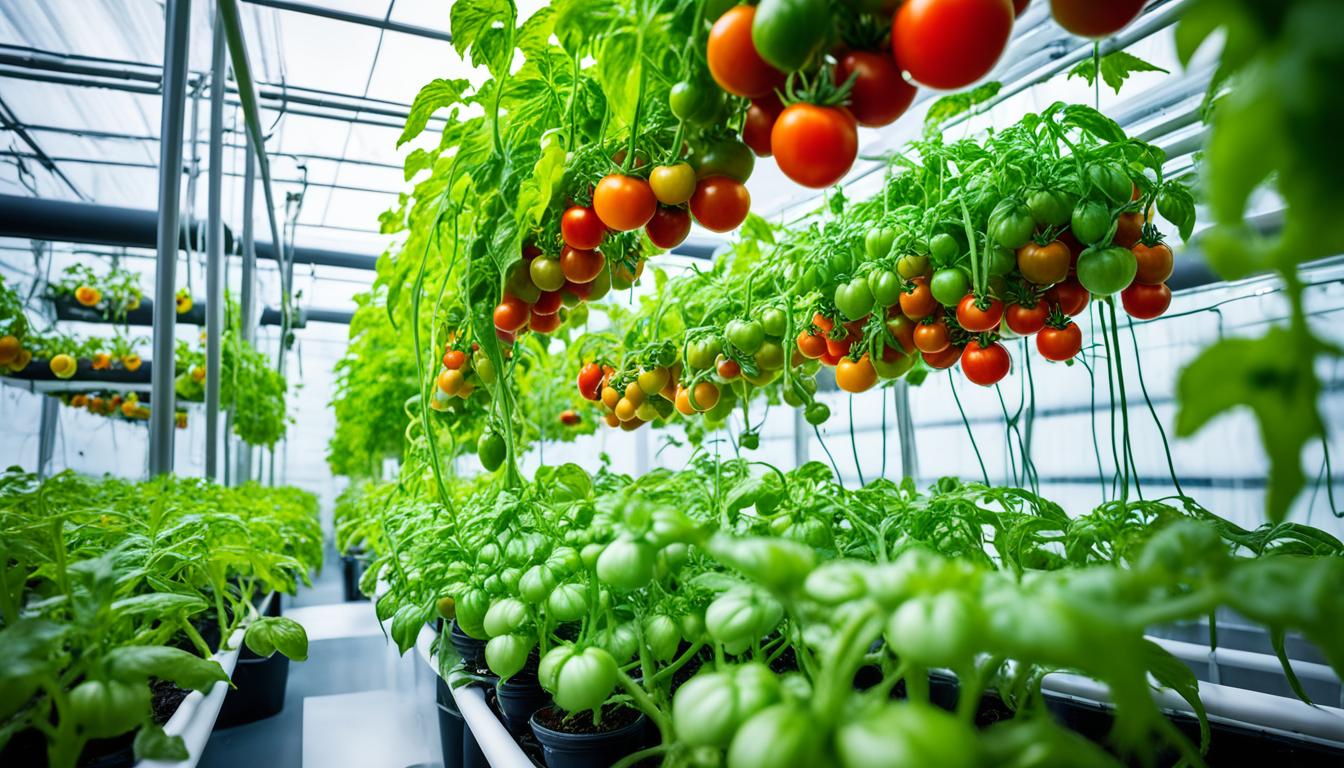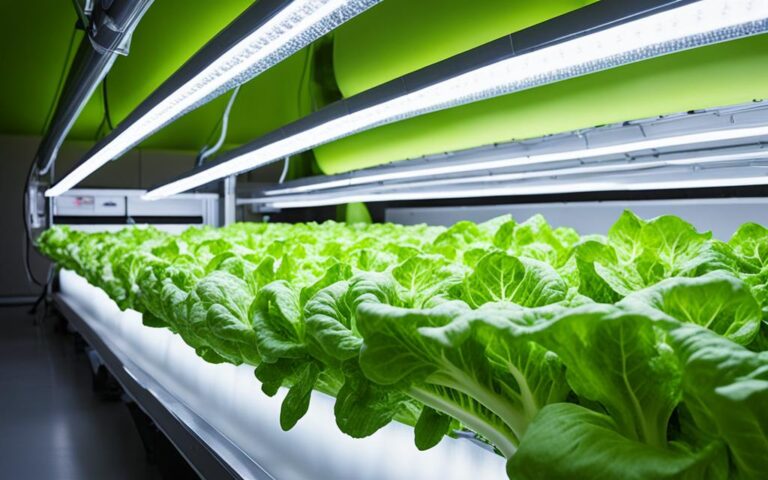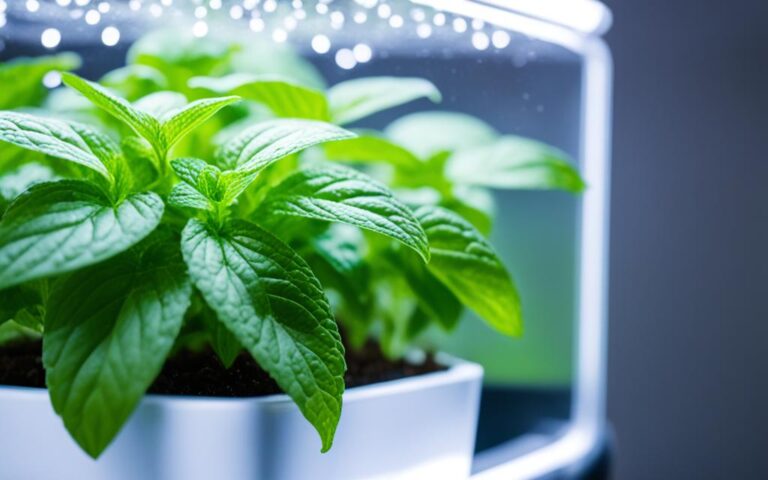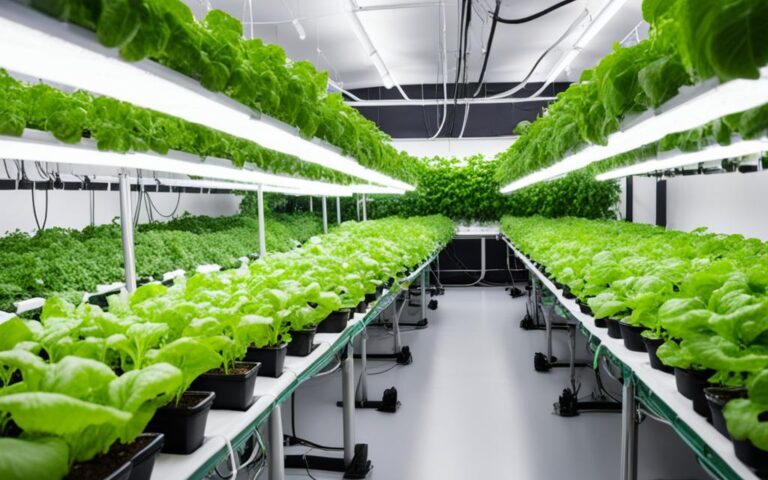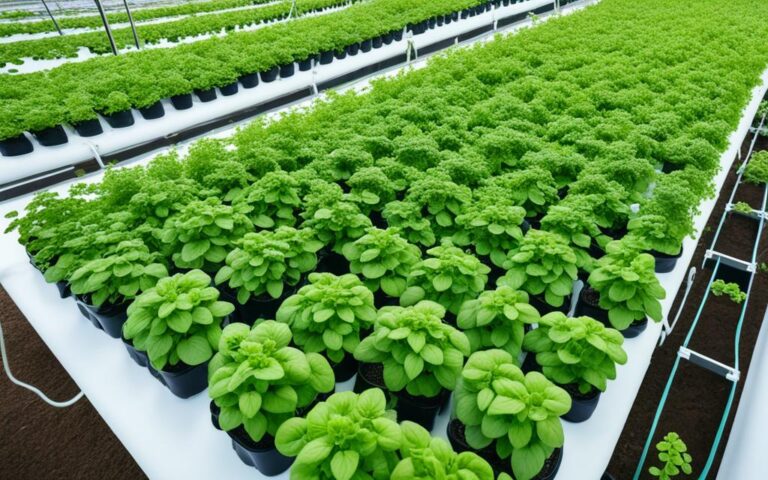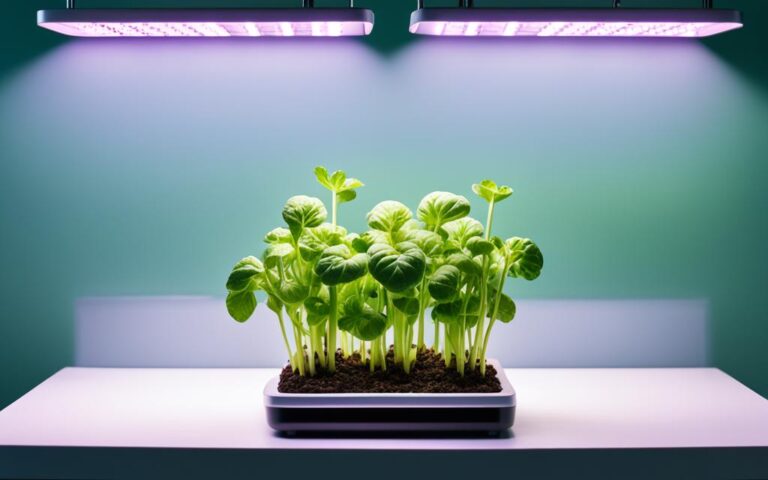Growing Hydroponic Tomatoes: Tips for Success
Tomatoes are a favorite in many cuisines around the world. But, their growing season is often short due to the weather. Hydroponic gardening has changed that, making it possible to grow indoor tomatoes all year. Whether you have a small space or a big greenhouse, hydroponic tomato farming is a great way to grow this versatile fruit.
This guide will help you grow successful hydroponic tomatoes. We’ll cover choosing the right system, taking care of your plants, and how to get the most yield. By using soilless cultivation and controlled environment agriculture, you can produce sustainable food and urban agriculture in your own vertical farming or organic hydroponics setup.
Key Takeaways
- Hydroponic tomato farming allows for year-round production and reliable access to fresh, local produce.
- Proper selection of the right hydroponic system and tomato varieties is crucial for success.
- Maintaining optimal environmental conditions, such as lighting, temperature, and nutrient management, is key for healthy plant growth.
- Careful monitoring and preventive measures can help avoid common pests and diseases in hydroponic tomato systems.
- Maximizing yield and productivity can be achieved through advanced techniques like crop rotation and companion planting.
Table of Contents
Introduction to Hydroponic Tomato Farming
Hydroponic tomato farming is a new way to grow these tasty fruits. It uses nutrient-rich water instead of soil. This method gives plants a perfect place to grow all year, leading to better tomatoes.
It’s great for growing tomatoes in cities, vertically, and in controlled places. The weather outside doesn’t affect the plants. This makes it a top choice for many farmers.
Advantages of Growing Tomatoes Hydroponically
Hydroponic farming has many benefits. It can produce up to 30% more tomatoes than traditional farming. It also uses less water and land, which is good for the planet.
These tomatoes grow quicker and can be grown all year. This means you can enjoy fresh, tasty tomatoes whenever you want.
Year-Round Tomato Production Indoors
One big plus of hydroponic farming is growing tomatoes indoors. Using greenhouses or vertical farms, growers control the weather. This means tomatoes are available all year, even in tough climates.
| Metric | Hydroponic Tomato Farming | Traditional Soil-Based Farming |
|---|---|---|
| Yield Increase | Up to 30% higher | Standard yields |
| Water Use | Significantly lower | Higher water consumption |
| Land Use | More space-efficient | Requires more land area |
| Growth Rate | Faster growth cycle | Slower growth rates |
| Production | Year-round cultivation | Seasonal production |
Hydroponic farming helps growers produce more, protect the environment, and give communities fresh tomatoes all year.
Selecting the Right Hydroponic System
Choosing the right hydroponic system for hydroponic tomatoes depends on space, budget, and how much you want to produce. There are several systems that work well for tomatoes, each with its own benefits and things to think about.
Types of Hydroponic Systems for Tomatoes
Popular hydroponic systems for tomatoes include:
- Deep Water Culture (DWC) systems, like the AeroGrow, great for small indoor gardens
- Nutrient Film Technique (NFT) systems, ideal for large-scale tomato production in greenhouses or urban agriculture settings
- Ebb and Flow (Flood and Drain) systems, suitable for hydroponic tomato farms and vertical farming setups
Each system has its own needs and things to consider, like how to manage water and nutrients, and the design of the system.
Space and Budget Considerations
When picking a hydroponic system for tomatoes, think about the space you have and your budget. Small DWC systems are good for indoor or urban gardens. But, if you’re looking at greenhouse or vertical farming, you might want bigger NFT or ebb and flow systems. Knowing what you can afford and what you want to achieve will help you pick the best system for growing tomato plants.
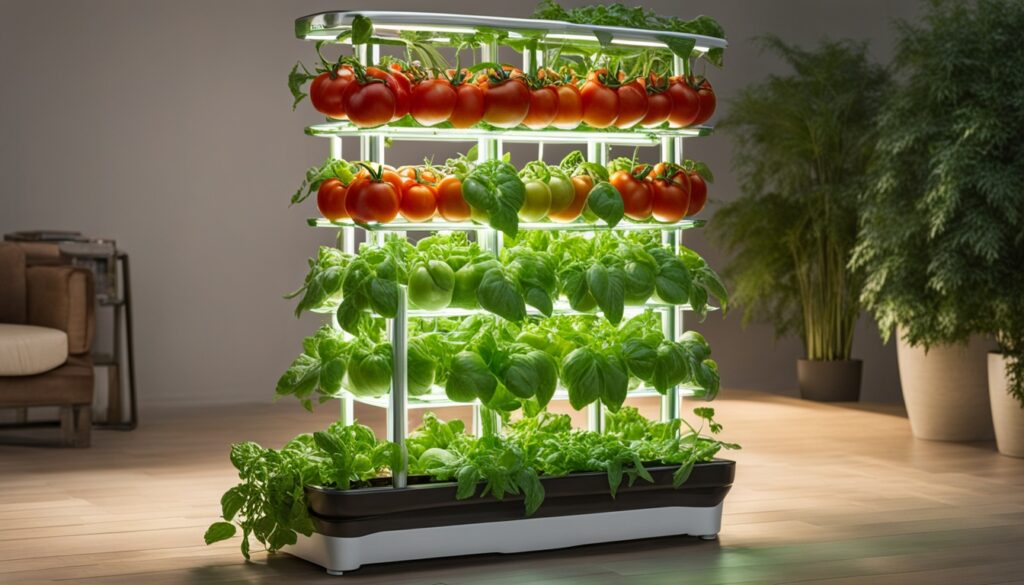
“Carefully considering your grow space, energy requirements, and financial resources will help you select the most appropriate hydroponic system for your tomato-growing goals.”
Choosing the Best Tomato Varieties
Choosing the right tomatoes for hydroponics is key to success. The right varieties can make a big difference. You should think about plant size, fruit type, and how long they take to mature.
Compact and determinate tomatoes like hydroponic Roma tomatoes and cherry tomatoes hydroponic do well in small spaces. They grow bushy and stop when they reach a certain height. This makes them perfect for small setups. On the other hand, big indeterminate tomatoes, such as hydroponic beefsteak tomatoes, need more room to grow.
Some heirloom tomatoes hydroponic also grow well hydroponically. They bring unique tastes and looks to your garden. These heritage tomatoes can make your hydroponic garden more interesting.
When picking the best hydroponic tomato varieties, talk to experienced growers and do your homework. This helps you find the best plants for your setup and environment.
| Tomato Variety | Fruit Type | Growth Habit | Suitability for Hydroponics |
|---|---|---|---|
| Roma | Plum/paste | Determinate | Excellent |
| Sweet 100 | Cherry | Indeterminate | Very Good |
| Brandywine | Heirloom | Indeterminate | Good |
| Big Beef | Beefsteak | Indeterminate | Moderate |
| Juliet | Grape | Indeterminate | Excellent |
By picking the right hydroponic tomato varieties, you can have a great harvest all year.
Starting from Seeds or Transplants
Growing hydroponic tomatoes can start with best hydroponic tomato seeds or hydroponic tomato transplants. Each method has its own benefits and things to consider.
Seed Germination Techniques
Starting with hydroponic tomato seeds gives you control over the growth. But, it needs careful attention to make sure they germinate. You can use rock wool cubes or the paper towel method.
Tomato seeds usually take 5 to 10 days to germinate. They need warmth and consistent moisture to grow.
Preparing Transplants for Hydroponics
Buying hydroponic tomato transplants can save time and make starting easier. These seedlings are 2 to 3 inches tall and ready for bigger containers. Before moving them, it’s important to get them used to the hydroponic setup.
This process, called “hardening off,” helps the plants adjust. It prepares them for the new environment.
Choosing to start with best hydroponic tomato seeds or hydroponic tomato transplants is up to you. The main goal is to give your plants the best start in the hydroponic system.

“A family of four can feast throughout the summer on just six tomato plants.”
Setting Up Your Hydroponic Environment
Creating the right environment is key for growing healthy hydroponic tomato plants. The right hydroponic tomato lighting is crucial. Tomatoes need red, blue, and white light for photosynthesis and fruit growth. LED grow lights are great for indoor systems because they’re energy-efficient and provide the full spectrum of light.
Having the correct hydroponic tomato temperature and hydroponic tomato humidity is vital for healthy growth. The ideal temperature is 70-85°F, and humidity should be 50-70%. This helps avoid problems like blossom end rot and diseases.
Lighting Requirements for Hydroponic Tomatoes
Hydroponic tomatoes need a lot of light, about 600 to 800 foot candles per square foot. LED grow lights can provide this amount of light efficiently. They give plants the full spectrum of light needed for growth.
Temperature and Humidity Control
Keeping the right temperature and humidity is key for hydroponic tomatoes. The ideal temperature is 65-75°F, with water at 68°F. Humidity should be 50-70% to prevent blossom end rot and boost plant health.
Hydroponic systems let tomato plants grow tall with good air flow. This setup helps avoid pests and diseases. It means you get disease-free tomatoes without pesticides.
“Hydroponic tomato growers have the ability to precisely control the growing environment, ensuring optimal conditions for plant health and productivity.”
Nutrient Management and Fertilization
Getting the right nutrients is key for hydroponic tomatoes to grow well. These plants need a mix of important nutrients like nitrogen (N), phosphorus (P), and potassium (K). They also need smaller amounts of other nutrients for healthy growth and lots of fruit.
Essential Nutrients for Tomato Growth
Special nutrient solutions for hydroponic tomatoes, with an NPK ratio of about 5-15-14, help plants grow strong. These solutions give tomatoes the right mix of nutrients. This includes calcium, magnesium, and trace minerals for healthy leaves, strong stems, and lots of fruit.
Adjusting pH and EC Levels
It’s important to check and tweak the pH (5.5-6.8) and electrical conductivity (EC) (2.0-5.0) of the nutrient solution often. Keeping these levels right helps plants take in nutrients well. This prevents problems that can hurt growth and how much they produce.
Watching and adjusting the hydroponic tomato nutrient solution is crucial. It depends on the plant’s growth stage and the environment. This ensures a big and quality tomato harvest.

“Proper nutrient management is the foundation for growing thriving hydroponic tomatoes that deliver exceptional flavor and yield.”
hydroponic Tomatoes Plant Care
For growing hydroponic tomatoes, it’s key to keep up with good plant care. Pruning and training the plants are crucial. They help control how the plants grow and make sure they put their energy into making more fruit.
Pruning and Training Techniques
Pruning hydroponic tomato plants means cutting off suckers. These are the shoots that grow between the main stem and the leaves. This helps the plant focus on growing a strong stem and making bigger, healthier fruits. Also, tying or trellising the plants keeps them tidy and lets air move around them better, which helps them get enough light.
Pollination Methods for Indoor Growing
Tomato flowers need pollination to produce fruit, which is tricky indoors. Without bees or other pollinators, growers must find other ways to pollinate. Methods like manually shaking the plants or using a small fan to mimic wind can help pollinate the plants and grow fruit.
| Technique | Benefit |
|---|---|
| Pruning Suckers | Directs plant energy into fruit production |
| Tying or Trellising | Maintains neat growth habit and improves air flow |
| Manual Shaking | Facilitates pollination in indoor environments |
| Using a Small Fan | Simulates wind movement to aid pollination |
Using pruning, training, and pollination methods helps hydroponic tomato growers. It keeps the plants healthy and increases the chance of a big harvest.
Pest and Disease Prevention
Hydroponic systems are designed to be more controlled, but they can still face pest and disease problems. It’s important for growers to watch out for these issues and deal with them fast. This keeps plants healthy and boosts yields. By using integrated pest management and taking steps to prevent diseases, hydroponic tomato farmers can beat common challenges and succeed.
Common Pests in Hydroponic Systems
Some pests that can bother hydroponic tomatoes are:
- Aphids: These small, soft insects eat plant sap, making plants grow poorly and leaves look twisted.
- Spider mites: These tiny arachnids love dry, warm places and can quickly spread, making leaves look bad and creating webs.
- Thrips: These thin insects hurt plant tissue, causing scars, color changes, and can spread viruses.
Using things like beneficial insects and organic pesticides can help control these pests in hydroponics.
Identifying and Treating Plant Diseases
Growers of hydroponic tomatoes need to keep an eye out for diseases like:
- Alternariosis: This disease shows as small rings on leaves and black spots on stems.
- Gray Rot: It looks like brown spots on leaves and flowers, and tomatoes get a gray, hairy rot.
- Powdery Mildew: Leaves get yellow spots that look like they’re dying.
- Downy Mildew: Leaves get spots that look oily and quickly die.
- Fusarium Wilt: Plants start to wilt, leaves turn yellow, and dry out.
Quickly finding and treating these diseases with organic fungicides and keeping growing conditions right can stop them from spreading in hydroponics.
“Keeping things clean is key to stopping tomato diseases. Using professional hydroponic systems can lower disease risk by making growing conditions better.”
Harvesting and Storage Tips
Knowing when to pick and how to store your hydroponic tomatoes is crucial. Tomatoes are ready when they’re the right size and have a deep red color. Carefully taking them off the plant helps keep them fresh.
For short-term storage, keep tomatoes at room temperature, between 64-70°F/18-21°C. This lets them ripen and taste better. For longer storage, you might need to refrigerate or can them.
Some tomatoes, like “Piennolo del Vesuvio” and “Vesuvio Giallo,” can be stored at room temperature for weeks. These “long keeper” tomatoes, including “Mystery Keeper,” “Pomodoro Ponderosa,” and “Reverend Morrow’s Long Keeper,” get their best flavor 2 months after picking. They’re great for storing in the pantry.
Green tomatoes can be made into pickles, canned, or fried. This way, you can enjoy them even after the growing season.
“Tomatoes rank number one in their contribution of nutrients to the American diet due to high consumption levels.”
Learning the best ways to harvest and store your hydroponic tomatoes lets you enjoy their fresh taste for longer.
Troubleshooting Common Issues
Even experienced hydroponic tomato growers face challenges. It’s key to spot and fix issues like nutrient shortages or stress from the environment. Keeping an eye on the hydroponic solution’s pH, electrical conductivity (EC), and nutrients helps solve problems.
Nutrient Deficiencies and Excesses
Getting nutrients right is crucial for hydroponic tomatoes. Nutrient deficiencies can cause slow growth, leaf discoloration, and less fruit. Nutrient excesses can harm plants too, causing leaf burn, too much foliage, and toxicity. It’s important to check and adjust nutrient levels to keep them balanced.
- Common nutrient deficiencies in hydroponic tomatoes include nitrogen, phosphorus, potassium, calcium, and magnesium.
- Symptoms of nutrient excesses may include leaf burn, stunted growth, and root damage.
- Adjusting the nutrient solution’s pH and EC levels can help address both deficiencies and excesses.
Environmental Stress Factors
Growers also need to watch out for environmental stressors that can hurt plant health and productivity. Things like temperature, humidity, and lighting affect tomato plants a lot. Keeping these conditions right is key for a successful hydroponic tomato setup.
- Temperature changes can cause blossom drop, fruit cracking, and sunscald.
- Not enough or too much humidity can lead to diseases and pests.
- Wrong lighting can make plants grow weak, look leggy, and produce less fruit.
By keeping an eye on and adjusting these factors, growers can make a great environment for their plants. This helps with their health and how well they produce.
“Diagnosing and addressing common issues in hydroponic tomato cultivation is crucial for maintaining a healthy, productive crop. With vigilance and proactive problem-solving, growers can overcome challenges and maximize their yield potential.”
Maximizing Yield and Productivity
For those growing hydroponic tomatoes, using crop rotation and companion planting can really help. By rotating tomatoes with cucumbers or peppers, you can refill nutrients and stop pests and diseases. Adding plants that help with pests or pollination can make your system work better and produce more.
Looking into nutrient film technique (NFT) or deep water culture (DWC) can also boost your tomato yields. These methods involve using channels or submerging roots in nutrient solutions. This gives plants steady oxygen and nutrients for better growth and more fruit.
Crop Rotation and Companion Planting
- Rotating tomato plants with other crops, such as cucumbers or peppers, can replenish nutrients and disrupt pest and disease cycles.
- Incorporating complementary plants with different nutrient needs or beneficial functions can enhance the overall system’s efficiency and productivity.
- Companion plants like marigolds or basil can deter pests and support pollination, contributing to higher tomato yields.
Advanced Hydroponic Techniques
- Nutrient film technique (NFT) systems use shallow channels with a constant flow of nutrient-rich water, providing steady oxygen and nutrients for plants.
- Deep water culture (DWC) systems submerge plant roots in a nutrient solution reservoir, requiring more maintenance but producing high yields.
- Wick systems deliver moisture through a wick to the roots as needed, offering an alternative hydroponic approach based on plant needs and space constraints.
Using these strategies and techniques, hydroponic tomato growers can maximize their yields and productivity. They can get high-quality, nutrient-dense tomatoes all year.
“Hydroponic tomatoes have evolved into a multi-billion dollar industry due to their productivity, efficiency, and year-round availability.”
Conclusion
Growing hydroponic tomatoes is a great way to have fresh tomatoes all year, even in small spaces. By picking the right hydroponic tomato farming system and tomato types, you can get lots of tasty tomatoes. It might take some learning, but the benefits are worth it for those into soilless growing.
Hydroponics can cut water use by up to 90% and boost tomato production by up to 30%. Some tomato types grow long and keep producing. With the right lights, temperature, and humidity, and good nutrients, hydroponic tomatoes do well in many systems.
Learning how to grow hydroponic tomatoes brings many benefits like constant production and more tomatoes with less water. This method is great for both experts and beginners in soilless growing. The tips in this article can help you succeed and enjoy the benefits of this new way to grow tomatoes.
